


 paradox
paradox
 , Ehrenfest paradox
, Ehrenfest paradox
(Fig.M) Einstein relativity rejecting the light medium causes many irreparable paradoxes due to its unphysical Lorentz transformation.
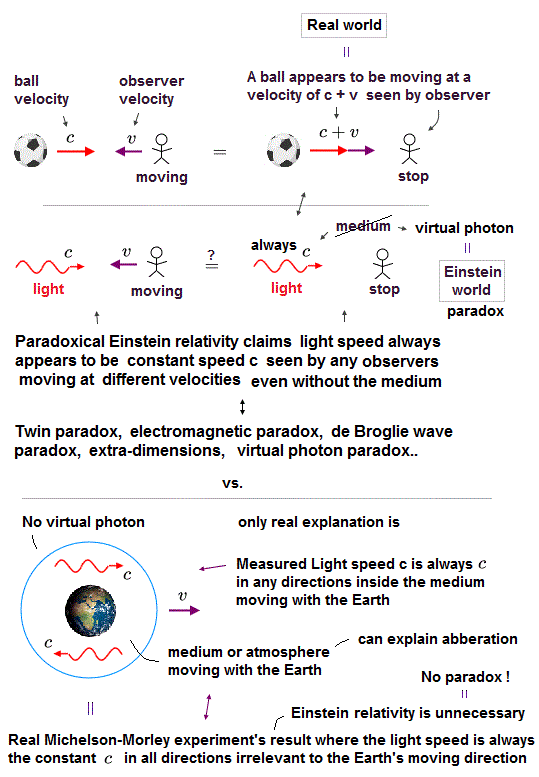
Michelson-Morley experiments showed the light speed is always the constant c when measured on the earth in any directions, which denied only the absolute luminiferous aether not moving with the earth.
↑ Because if the light travels through the absolute medium (= ether ) independent of the earth's motion at light speed c, the light speed should be measured to be faster or slower than c, depending on the directions in which earth is moving inside the absolute ether, which contradicts Michelson-Morley experiment (= but agrees with Michelson-Gale experiment ).
This Michelson-Morley experiment perfectly agrees with the ether (= light medium ) moving with the earth where the light always travels at the constant speed c in the earth medium, which "medium (= ether ) dragged by the earth" is also perfectly compatible with stellar aberration, contrary to wrong textbooks.
↑ The constant light speed in the medium is like the constant sound speed in the same atmospheric medium.
Actually, the light speed, which is naturally derived by classical Maxwell theory, changes depending on the medium.
The medium filling the space is definitely necessary to explain interference and refraction of light and de Broglie wave without relying on unreal quantum mechanical parallel universes and contradictory virtual particles.
Einstein wrongly rejected the real light medium (= luminiferous ether ), and created paradoxical relativistic theory based on Lorentz transformation to explain the constant light speed c seen by any moving observers ( this-p.10 ).
According to this unphysical relativistic Lorentz transformation where the time (= t ) and space (= x ) are unrealistically changed depending on observers' motion, the clock time is said to slow down and stop, as the clock's speed is closer to the light speed c.
↑ Contrary to the wrong textbooks, this relativistic Lorentz transformation rejecting the light medium causes many irreparable paradoxes such as twin time dilation, electromagnetic, Ehrenfest, virtual photons, Sagnac effect, kinetic, de Broglie wave, relativistic energy mc2, interference of light and an electron, superluminal spin, spin-orbit, black hole, gravitational wave, redshift, and extradimensions....
Contrary to many hypes, Einstein relativistic theory is completely useless for any technologies such as GPS and PET.
So the relativistic theory based on Lorentz transformation is proven false. ← The real light medium moving with (= dragged by ) the earth can perfectly solve these paradoxes.
(Fig.A) Snell's law proves stellar aberration is seen also in the light medium moving with the earth (= ether drag ).
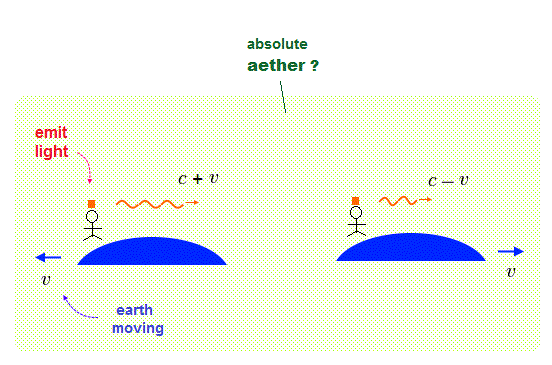
Contrary to wrong textbooks' explanation, the stellar aberration (= light emitted from a distance star appears to be inclined by the earth's motion ) can be observed also by the light medium moving with the earth (= compatible with Michelson-Morley experiment, too ).
As shown in the upper figure, the light emitted from a distant star appears to be traveling in the outer space slightly faster than light, as seen by the earth moving at a speed of v.
When this light enters the medium moving with the earth, the light speed becomes the constant c.
According to Snell's law, the ratio of the light angles (= singθ1/sinθ2 ) is approximately 1 due to the almost same light velocities in the outer space and the earth medium.
As a result, the light path remains inclined (= θ2 is not zero ) also in the earth medium that can observe the stellar aberration and Fizeau's partial ether drag.
↑ If textbooks' (wrong) idea that the ether dragged by the earth cannot explain aberration ( this-p.2, this middle ) is right, The angle θ2 must be zero, which means the light speed inside the earth medium must be unrealistically zero, so the aberration is compatible with the ether (= medium ) moving with the earth, after all.
This-p.3-Discussion says "The empirical aberration evidence supporting the dragged ether theory is thus overwhelming."
(Fig.S) The light speed is faster or slower than c by the earth spinning in Sagnac effect disproving Einstein relativity claiming the constant light speed c.
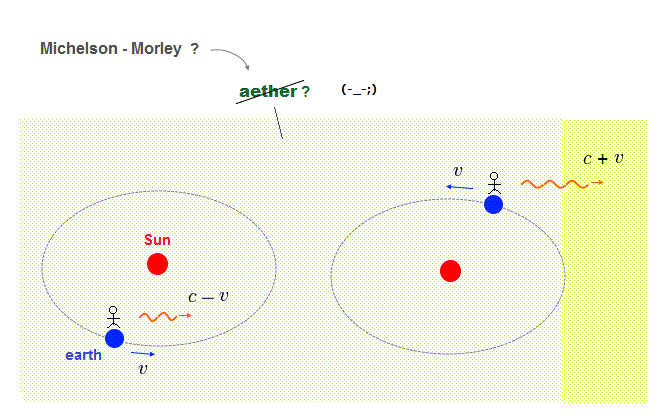
Einstein relativity is wrong due to its fatal contradiction in Sagnac effect where light's speed can be faster or slower than c, which contradicts the relativistic postulate that the constant light speed c should be always measured by any observers.
Actually the light emitted from a satellite is observed to be faster (= c + v ) or slower (= c - v ) than light speed c by the earth rotation (= rotation speed v, this-p.1-lower~p.2 ), which disproves Einstein relativity ( this-p.1-lower,p.3-conclusion ).
↑ The point is the light speed is Not affected by the earth rotating around the sun or galactic center, which means the light emitted from a satellite travels at light speed c in the medium moving with the earth.
Sagnac effect where the light is faster or slower than light speed c only by the earth's spinning (= Not by the earth rotating around the sun ) is compatible with the light medium moving with the earth.
And this medium moving with the earth is not dragged by the earth's spinning like the atmosphere (= because the earth's gravity affects only vertical direction, Not horizontal direction ), which can naturally explain why light speed is affected only by the earth's spinning, Not by the earth's rotating around the sun in Sagnac effect.
↑ Like the atmospheric molecules moving in random directions, the light medium's substance moving with the earth is moving in various (= random ) directions, and colliding with buildings near the earth surface, which makes the medium appear to be moving with (= Not dragged by ) the earth spinning only near the earth surface, which can explain the light speed emitted by a distant satellite changed by the earth spinning.
This real light medium moving with the earth and not dragged by the earth spinning can also explain Michelson-Gale experiment where the light detector slightly rotating with the empty rectangular pipe (= whose rotating wall does not push the medium inside the empty pipe in the rotating direction ) can measure slightly faster or slower than light speed c.
(Fig.V) Einstein relativity rejecting the real medium needs unreal virtual photons with imaginary mass, which disproves Einstein.
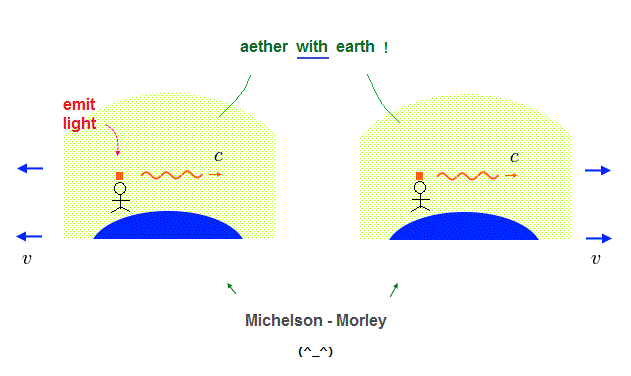
Einstein relativity rejecting the light medium paradoxically needs fictional virtual photons with imaginary mass to explain electromagnetic force and photoelectric effect ( this-p.16 ).
Without the medium, an electron can emit or absorb only unreal virtual photons with imaginary mass (= m2 < 0 ) paradoxically disobeying Einstein relativistic energy-mass relation called off mass shell ( this-p.3, this-p.4-6, this-5th-paragraph ).
The reliance on these unreal virtual photons disproves Einstein relativity and the unphysical relativistic quantum electrodynamics (= QED ) giving only meaningless infinities that must be illegitimately removed by renormalization ( this-p.4-5 ), which ad-hoc QED trick, which cannot predict any physical values, was criticized by many physicists ( this-1st-paragraph ).
(Fig.T) Einstein relativity is wrong, needing unreal quantum mechanical parallel universes in two slit interference.
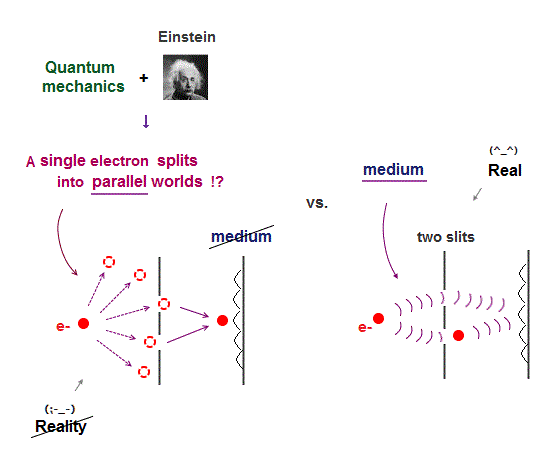
A single particle such as an electron is known to interfere with itself in two-slit experiments.
We can naturally say an electron generates real de Broglie wave in the medium causing interference (= de Broglie wave instead of a single electron can pass two slits realistically ).
But in the unphysical Einstein relativity rejecting the medium, a single electron has to split into multiple (fictional) parallel universes (= one electron unrealistically splits into two slits ) to interfere with itself by the paradoxical quantum mechanical wave-particle duality.
↑ As a result, disproving Einstein relativity rejecting the real medium by fatal paradoxes is equal to disproving quantum mechanical wave-particle duality in fantasy parallel universes.
Real de Broglie wave (= whose wave phase is moving with a moving electron ) disproves the unphysical quantum mechanical static probability wavefunctions that cannot be changed nor moved.
(Fig.P) Light refraction due to different light speeds in different mediums cannot be explained by Einstein relativity rejecting the medium or a unreal photon particle.
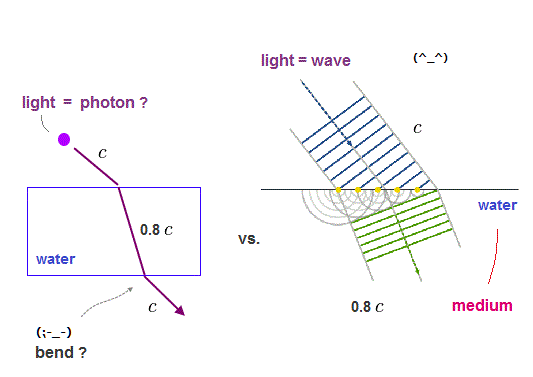
Light is clearly wave traveling and interfering in the medium as shown in Light refraction caused by the difference in light speeds in different mediums according to Huygens principle.
Einstein relativity rejecting the medium needs an unreal photon particle that cannot explain light interference nor refraction (= a photon particle can only collide with each other without interference ).
Because in the light refraction, a (illusory) photon particle has to unreasonably slow down and accelerate at some definite angles by some fictional forces, each time it enters different mediums, which also contradicts Einstein relativity of the constant light speed c.
(Fig.K) An electron-1 paradoxically has kinetic energy (and de Broglie wave ) emitted as light as seen by a stationary K, or no kinetic energy (= no de Broglie wave nor emitting light ? ) as seen by a moving K'
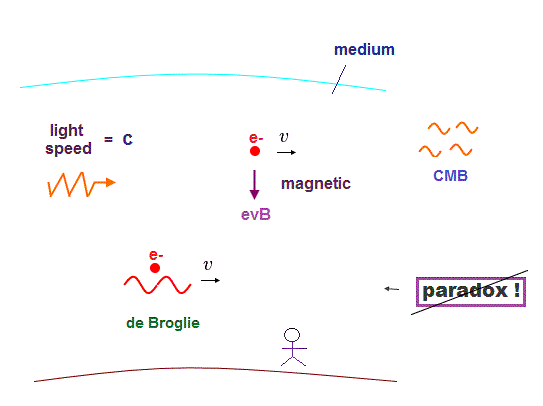
Einstein relativistic theory rejecting the medium (= luminiferous aether ) has No absolute frame in the space where what objects are moving or stationary are changed depending on which observers seeing them.
So according to the paradoxical Einstein relativity, an electron-1, which is moving at speed of v emitting light energy and generating de Broglie wave interference as seen by the stationary K, paradoxically appears to stop with No kinetic energy that cannot be emitted as light energy nor generate de Broglie wave interference (= de Broglie wavelength changes depending on the particle's velocity ) as seen by K' moving at the same speed as the electron-1.
↑ These paradoxes in kinetic energy and de Broglie wave clearly disprove Einstein relativity.
Because one stationary observer (= K ) sees the moving electron-1 (= with kinetic energy ) emitting light energy and causing de Broglie wave interference, while another moving observer (= K' ) sees the same electron-1 (= stopping with No kinetic energy to lose ) Not emitting light (= or a stationary electron paradoxically emits light energy ) nor generating de Broglie wave interference on the screen.
↑ Einstein relativity is false, violating energy and momentum conservation.
↑ To solve this fatal relativistic paradox in kinetic energy, physicists introduced the contradictory idea called Unruh effect where the empty vacuum paradoxically emits light (= meaning the vacuum filled with light medium or ether or unreal virtual particles, this-5th-paragraph ) when observers start to accelerate, which clearly disproves Einstein saying the vacuum is empty with No energy ( this-1~2nd-paragraphs ).
↑ Actually, this Unruh effect is unrealistic, too small to observe ( this-3rd-paragraph, this-p.1-left-1st-paragraph, this-1st-paragraph ) , so this relativistic kinetic energy paradox cannot be solved even by this artificial Unruh effect seen by accelerating observers.
↑ Einstein relativity is false, violating energy or momentum conservation law.
The only legitimate solution to this relativistic kinetic energy (= light-emitting ) paradox is that an electron moving relative to the real light medium has kinetic energy to emit light energy and generate de Broglie wave interference (and Lorentz magnetic force ) regardless of observers, which rejected Einstein relativity.
(Fig.R) An electron and a proton increase their kinetic and relativistic energy, but the total (relativistic) energy of a hydrogen (= H ) atom decreases due to the lower potential energy in the medium (= Not particles' kinetic energy ), which fact disproves Einstein.
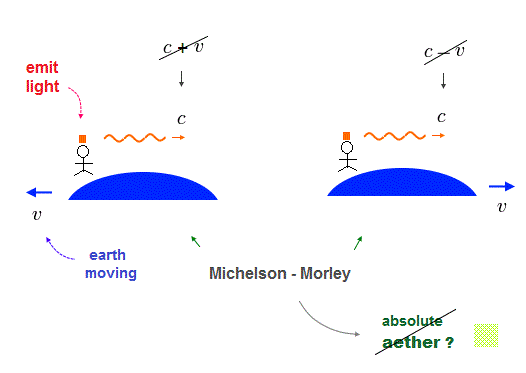
Einstein relativistic energy is wrong, because it needs the potential energy ( this-3rd-paragraph ) stored in the medium disproving Einstein relativity rejecting the medium.
In the upper figure, an electron and a proton separated by an infinite distance (= with zero Coulomb potential energy ) are stationary (= No kinetic energy ) with only the rest mass energy of m0c2.
When this electron and the proton attract each other and form a hydrogen (= H ) atom, their kinetic and relativistic energy related to the particle's velocity increases (= an electron starts to be moving around the proton inside a H atom due to Virial theorem ).
But the total (relativistic) energy of the H atom decreases due to the lower Coulomb attractive potential energy between an electron and a proton ( this-p.4 ).
↑ This is paradox, because the total relativistic energy of the H atom decreases due to the potential energy in the medium which Einstein rejected, around the electron and the proton whose kinetic energy increases.
Actually the mass energy equation of mc2 was first derived by classical Maxwell theory (= with the medium = No need for paradoxical Einstein relativity ), which was illegitimately copied by the paradoxical Einstein relativity. later ( this-p.3~ ).
(Fig.Q) Einstein relativistic theory rejecting the real medium causes unphysical quantum mechanical wavefunction or parallel universes.
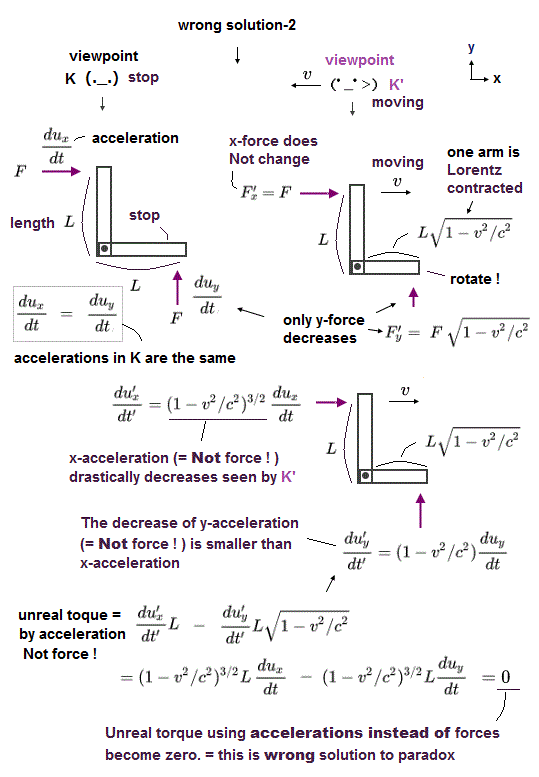
As shown in fatal relativistic paradoxes such as Lorentz force, twin, length, kinetic energy, de Broglie wave, faster-than-light-Sagnac effect, mc2 energy, contradictory gravitational wave, black hole, Einstein relativity is officially proven wrong.
The fact that Einstein relativity rejecting the medium (= ether, this-p.10 ) is wrong means the electron's de Broglie wave is real wave generated in the real medium (= agreeing with stellar aberration ), which disproves quantum mechanical unphysical wavefunction or wave-particle duality against reality, too.
Real de Broglie wave whose wave phase is constantly changing with a moving electron disproves the unphysical quantum mechanical static probability wavefunctions that cannot be changed nor moved.
Einstein relativistic theory introduced the paradoxical Lorentz transformation or time dilation by trying to explain the constant light speed c on the earth without the real medium (= aether ) in space.
So in this unphysical Einstein relativistic world without the real medium in space, physicists have to unrealistically treat each electrons as a particle and wave simultaneously called wave-particle duality.
Quantum mechanics based on this paradoxical Einstein relativity claims a single electron (unrealistically) splits into many different places by (fictional) quantum superposition or parallel universes to interfere with itself in two-slit experiments ( this-2nd-last-paragraph, this-4-5th-paragraphs ).
↑ If Einstein relativity is wrong, we can naturally explain this contradictory wave-particle duality and two-slit-experiment of a single electron's interference by separating a real electron particle and real de Broglie wave generated around the electron.
A photon particle is illusion just light wave ( contradictory virtual photons are unreal ) in the medium.
Due to paradoxical Einstein relativity rejecting medium, physicists unable to separate a real electron particle and real de Broglie wave generated in the medium have to use unphysical quantum mechanical probability wavefunction or contradictory wave-particle duality.
This quantum mechanical ( paradoxical ) probability wavefunction is unrealistic, based on unscientific superposition where each electron must exist in all places at once in fantasy parallel universes until measured, like in two slit experiments of a single electron or a photon.
Physicists can Not determine each electron's position (= uncertainty principle ) in this unphysical quantum mechanical probability wavefunction that always includes impossible negative kinetic energy area.
Furthermore, quantum mechanical electrons in s orbitals are said to have (unreal) zero orbital angular momentums, which means those electrons moving in linear orbits (= zero orbital angular momentum ) always crash into nuclei, and their de Broglie wave causes destructive interference, and become unstable.
↑ All these paradoxical unphysical quantum mechanical probability wavefunction can be replaced by real atomic model based on real electrons (= non-zero angular momentum, so not crashing into a nucleus ) and de Broglie wave.
Quantum mechanical wavefunction has to rely on unphysical exchange energy (+ paradoxical superluminal electron spinning ) based on pseudo-kinetic energy change caused by the wavefunction interference (= hampering science due to shapeless wavefunction ) to express Pauli repulsion, which can be naturally replaced by real de Broglie wave interference.
Einstein relativity is proved to be wrong due to its fatal paradox.
So a small energy splitting called fine structure is caused Not by the (paradoxical) relativistic spin-orbit magnetic energy ( this p.6 ) in quantum mechanical Dirac hydrogen, but by real Bohr-Sommerfeld's fine structure without spin.
This p.14-4th and last paragraphs says
"Sommerfeld’s fine-structure formula was spectroscopically confirmed for
H and for hydrogenic ions (He+,
Li2+, ...) to the highest precision—the greatest triumph
of the old quantum theory"
"Over a decade later, after the electron spin had
been discovered, relativistic quantum mechanics
(Dirac 1928) obtained the fine-structure formula (Gordon 1928) along a very
different route....
yields the same energies as Sommerfeld’s formula"
This-3rd-last-paragraph says,
"When Dirac developed relativistic quantum mechanics, the relativistic Coulomb problem proved to be exactly solvable ...But the resulting formula for the energy levels was truly a surprise: The new answer was precisely the old Sommerfeld formula !"
This realistic Bohr-Sommerfeld model relies on Maxwell's authentic mc2 energy (= classical Maxwell theory first proved the energy E stored in the medium has mass m equal to E/c2 ) that was copied as the paradoxical relativistic mass later by Einstein.
Einstein relativity is paradoxical and wrong, which means all relativistic quantum theories such as QED, quantum field theory and standard model using paradoxical virtual particles with imaginary masses are wrong, too.
Today's only theory of everything allegedly unifying Einstein relativity and quantum mechanics is fictional extra-dimensional string theory ( this-4th-last-paragraph ), which is also wrong, if Einstein relativity is wrong.
Actually, these unphysical QED and particle physics are completely useless, just wasting huge taxpayer's money in unnecessary gigantic colliders.
(Fig.P1) Different clock times in different positions.
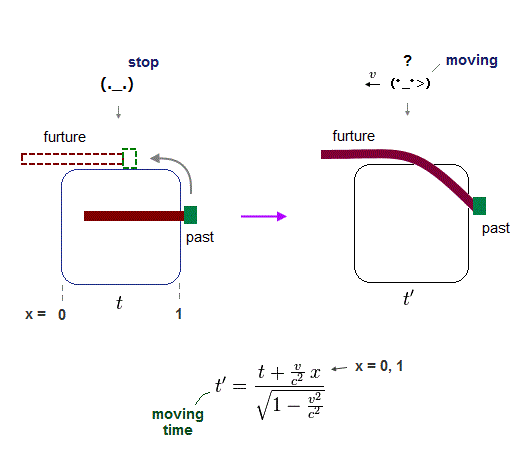
Here we present a typical example of fatal paradox in Einstein relativity.
In Einstein relativity, a moving ovserver has an unrealistic power to bend even a rigid rod without touching it , no matter how hard the rod is, as seen in Lorentz contraction.
A rigid rod is moving upward at first and then turn to the left horizontally along the rigid square rail in the upper figure.
External forces are always applied to any positions of the long rod uniformly, in both leftward and upward directions (= at first, the rod cannot move to the left, blocked by the vertical rail on the right side. )
Surprisingly, as seen by a moving observer, this originally-straight rigid rod appears to be bent complexly, as seen in the upper figure right.
According to relativistic Lorentz transformation, events occurring in different positions (= x = 0, 1 ) at the same time (= t ) seen by stationary observer occur at the different times (= t' ) seen by a moving observer !
By inserting two positions x = 0 and 1 (= same time t by stationary observer ) into Lorentz tansformation, we find a moving observer sees the left end of rod turning to the left earlier than the right end of the rod.
Hence, a moving observer tends to see the future event of the left end of the rod and the past of the right end of the rod. which appears to bend the rod like in the upper figure right.
This occult world is Einstein special relativity.
(Fig.P2) "Block" changes the rod "future" direction.
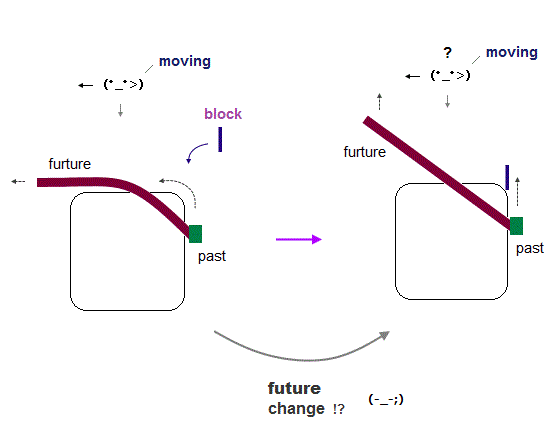
So in Einstein fantasy relativistic world, a rigid rod "can" foresee the future !
In the upper figure, the right end of the rod (= still existing in the past ) has Not arrived at the turning point, but the left end of the rod (= existing in the future ) has already turned to the left at the turning point.
If someone suddenly puts a new block onto the turning point, the whole rigid rod (= including left and right ends of the rod ) cannot move leftward (= the whole rigid rod cannot turn to the left ), meaning the left end of the rod already turning leftward suddenly changes its past event and its direction (= as if moving upward from the beginning without turning to the left at the turning point ) without touching the rod !
This is paradoxical and impossible, because the right end of the rod (= past ) has Neither arrived at the turning point nor known whether a block is there or not.
But the left end of the rod can automatically predict the future event (= can know whether a new block is put at the turning point without touching it ), and make a decision whether it will bend (= moving leftward ) or bend back (= moving upward without turning leftward ) !
This is one of fatal paradoxes of Einstein relativity which theory proved to be wrong just by this paradox.
Here we suppose external force is always applied to any points of the rod uniformly, so the moment the rod arrives at the turning point without a block, the whole rod starts to turn to the left without delay simultaneously.
See Einstein is wrong in electromagnetic field.
See Einstein relativity de Broglie wave paradox
See Einstein relativity contradicts kinetic energy.
See Relativistic mass is unreal.
See Twin paradox is real, Einstein is wrong.
See GPS doesn't use relativity.
(Fig.U) Driving force to expand universe is dark energy ← NOT diluted ? Unreal negative pressure ?
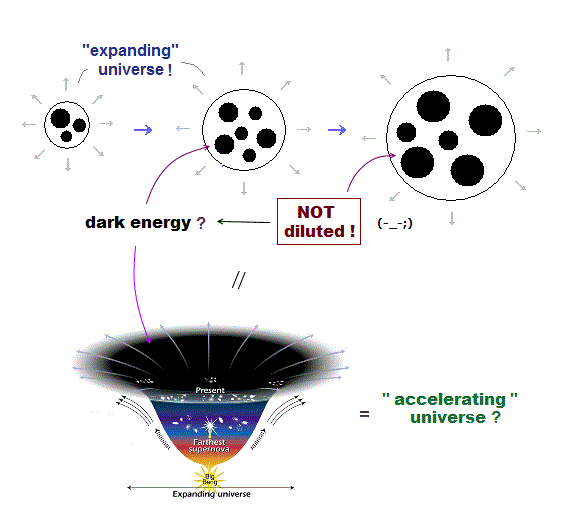
Big Bang and expanding universe are just fantasy.
There is No evidence indicating our universe is expanding so rapidly, as seen in the fact that our solar system is Not expanding at all.
The current cosmology claims the entire universe is expanding by fictional dark energy with unreal negative pressure, which is said to be Not diluted even by the space expansion ( this 2nd-paragraph ). ← Dark energy is Not a real thing !
They baselessly conjecture that universe is expanding only from the fact that light emitted from more distant stars is redshifted (= longer wavelength ), which can be more naturally explained by lights from more distant stars tend to lose their energies, elongate their wavelength by being scattered by more dusts and or by oscillating other molecules while light is traveling an extremely long distance.
The most conclusive evidence of fantasy Big Bang is said to be an uniform cosmic microwave background (= CMB ) which is unrealistically misinterpreted as a remnant of the beginning of our universe.
But it's impossible for each microwave to keep an intact state of very ancient light wave from the early universe for as long time as 13.8 billion years !
So it is more natural to think that the uniform cosmic microwave filling all space is an evidence of uniform light "medium (= slightly oscillating at 3 K )" filling space.
The current astronomy focuses only on fictional science saying this cosmic microwave may indicate fantasy parallel universes. ← nonsense.
Astronomers often cite "Olber's paradox (= why night sky is dark )" as a reason for the (fictional) expanding universe or BigBang, but this Olber's paradox does Not justify the expanding universe at all.
According to Olber's paradox, if the universe is static and infinite filled with luminous objects (= stars ), every sight line from the Earth will eventually intersect a bright object, it means the night sky will be bright, hence, the universe should be finite and expanding (= BigBang ) to solve this paradox and make the night sky dark.
And they misleadingly claim that even if dusts or debris in the space could absorb the light, they heat up and eventually reradiate the same light towards the Earth (← this is wrong ), hence the existence of dusts doesn't solve this Olber's paradox ( this resolution ).
↑ But this logic of expanding universe intentionally avoids the case where many dusts and objects in the space block and reflect the light back to the stars, as seen in the solar eclipse ( this 5th-paragraph ).
In conclusion, Olber's paradox is caused by forgetting the case of light reflection, and the expanding universe and BigBang are false.
See Gravitational wave is unreal

Feel free to link to this site.